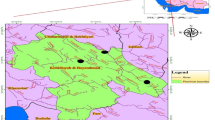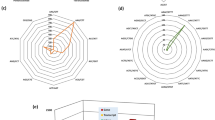Abstract
Background
The dojo loach Misgurnus anguillicaudatus is an important economic species in Asia because of its nutritional value and broad environmental adaptability. Despite its economic importance, genomic data for M. anguillicaudatus is currently unavailable.
Methods and results
In the present study, we conducted a genome survey of M. anguillicaudatus using next-generation sequencing technology. Its genome size was estimated to be 1105.97 Mb by using K-mer analysis, and its heterozygosity ratio, repeat sequence content, GC content were 1.45%, 58.98%, and 38.03%, respectively. A total of 376,357 microsatellite motifs were identified, and mononucleotides, with a frequency of 42.57%, were the most frequently repeated motifs, followed by 40.83% dinucleotide, 7.49% trinucleotide, 8.09% tetranucleotide, and 0.91% pentanucleotide motifs. The AC/GT, AAT/ATT, and ACAG/CTGT repeats were the most abundant motifs among dinucleotide, trinucleotide, and tetranucleotide motifs, respectively. Besides, the complete mitochondrial genome was sequenced. Based on the Maximum Likelihood and Bayesian inference analyses, M. anguillicaudatus yingde in this study was the “introgressed” mitochondrial type. Seventy microsatellite loci were randomly selected from detected SSR loci to test polymorphic, of which, 20 microsatellite loci were assessed in 30 individuals from a wild population. The number of alleles (Na), observed heterozygosity (Ho), and expected heterozygosity (He) per locus ranged from 7 to 19, 0.400 to 0.933, and 0.752 to 0.938, respectively. All 20 loci were highly informative (PIC > 0.700). Eight loci deviated from Hardy–Weinberg equilibrium after Bonferroni correction (P < 0.05).
Conclusions
This is the first report of genome survey sequencing in M. anguillicaudatus, genome information, mitochondrial genome, and microsatellite markers will be valuable for further studies on population genetic analysis, natural resource conservation, and molecular marker-assisted selective breeding.





Similar content being viewed by others
Data availability
The data used to support the findings of this study are available from the article and its supplementary information.
References
Zhou W, Hu YY, Sui ZH et al (2013) Genome survey sequencing and genetic background characterization of Gracilariopsis lemaneiformis (Rhodophyta) based on next-generation sequencing. PloS One 8(7):e69909
Lu X, Luan S, Kong J et al (2017) Genome-wide mining, characterization, and development of microsatellite markers in Marsupenaeus japonicus by genome survey sequencing. Chin J Oceanol Limn 35(1):203–214
Shi LL, Yi SK, Li YK (2018) Genome survey sequencing of red swamp crayfish Procambarus clarkii. Mol Biol Rep 45(5):799–806
Song H, Zhang YX, Yang MJ et al (2018) Genome survey on invasive veined rapa whelk (Rapana venosa) and development of microsatellite loci on large scale. J Genet 97:e79–e86
Li ZY, Tian CX, Huang Y et al (2019) A first insight into a draft genome of silver sillago (Sillago sihama) via genome survey sequencing. Animals 9(10):1–8
Romana-Eguia MRR, Ikeda M, Basiao ZU et al (2004) Genetic diversity in farmed Asian Nile and red hybrid tilapia stocks evaluated from microsatellite and mitochondrial DNA analysis. Aquaculture 236(1):131–150
O’Connell M, Wright JM (1997) Microsatellite DNA in fishes. Rev Fish Biol Fisher 7(3):331–363
Andersson L, Haley C, Ellegren H et al (1994) Genetic mapping of quantitative trait loci for growth and fatness in pigs. Science 263(5154):1771–1774
Fang S, Wu R, Shi X et al (2020) Genome survey and identification of polymorphic microsatellites provide genomic information and molecular markers for the red crab Charybdis feriatus (Linnaeus, 1758) (Decapoda: Brachyura: Portunidae). J Crustacean Biol 40(1):76–81
Qiu B, Fang S, Ikhwanuddin M et al (2020) Genome survey and development of polymorphic microsatellite loci for Sillago sihama based on Illumina sequencing technology. Mol Biol Rep 47(4):3011–3017
Zhou YL, Wu JJ, Wang ZW et al (2021) Microsatellite polymorphism and genetic differentiation of different populations screened from genome survey sequencing in red-tail catfish (Hemibagrus wyckioides). Aquac Rep 19:241–250
Zhong J, Yi S, Ma L et al (1901) (2019) Evolution and phylogeography analysis of diploid and polyploid Misgurnus anguillicaudatus populations across China. Proc Royal Soc B 286:20190076
Li YJ, Yin J, Wang JB et al (2008) A study on the distribution of polyploid loaches in China. Nippon Suisan Gakk 74(2):177–182
Huang SQ, Cao XJ, Tian XC et al (2016) High-Throughput sequencing identifies microRNAs from posterior intestine of loach (Misgurnus anguillicaudatus) and their response to intestinal air-breathing inhibition. PloS One 11(2):e0149123
Feng B, Yi SV, Zhang MM et al (2018) Development of novel EST-SSR markers for ploidy identification based on de novo transcriptome assembly for Misgurnus anguillicaudatus. PloS One 13(4):e0195829
Liu BH, Shi YJ, Yuan JY et al (2013) Estimation of genomic characteristics by analyzing k-mer frequency in de novo genome projects. Quant Biol 35:62–67
Luo RB, Liu BH, Xie YL et al (2012) SOAPdenovo2: an empirically improved memory-efficient short-read de novo assembler. Gigascience 1(1):1–6
Li RQ, Yu C, Li YR et al (2009) SOAP2: an improved ultrafast tool for short read alignment. Bioinformatics 25(15):1966–1967
Huelsenbeck JP, Ronquist F (2001) MRBAYES: Bayesian inference of phylogenetic trees. Bioinformatics 17(8):754–755
Lanfear R, Calcott B, Ho SYW et al (2012) PartitionFinder: combined selection of partitioning schemes and substitution models for phylogenetic analyses. Mol Biol Evol 29:1695–1701
Schuelke M (2000) An economic method for the fluorescent labeling of PCR fragments. Nat Biotechnol 18(2):233–234
Botstein D, White RL, Skolnick M et al (1980) Construction of a genetic linkage map in man using restriction fragment length polymorphism. Am J Hum Genet 32(3):314–331
Cui L, Abbas K, Yu Y et al (2013) First record of the natural occurrence of pentaploid loach, Misgurnus anguillicaudatus in Hubei Province, China. Folia Zool 62(1):14–18
Abbas K, Li MY, Wang WM et al (2009) First record of the natural occurrence of hexaploid loach Misgurnus anguillicaudatus in Hubei Province, China. J Fish Biol 75(2):435–441
Arai K (2003) Genetics of the loach, Misgurnus anguillicaudatus: recent progress and perspective. Folia Biol 51:107–117
Lien S, Koop BF, Sandve SR et al (2016) The Atlantic salmon genome provides insights into rediploidization. Nature 533:200–205
Xu P, Zhang XF, Wang XM et al (2014) Genome sequence and genetic diversity of the common carp, Cyprinus carpio. Nat Genet 46(11):1212–1219
Berthelot C, Brunet F, Chalopin D et al (2014) The rainbow trout genome provides novel insights into evolution after whole-genome duplication in vertebrates. Nat Commun 5(1):3657–3667
Kasahara M, Naruse K, Sasaki S et al (2007) The medaka draft genome and insights into vertebrate genome evolution. Nature 447(7145):714–719
Chen BJ, Sun ZC, Lou FR et al (2020) Genomic characteristics and profile of microsatellite primers for Acanthogobius ommaturus by genome survey sequencing. Bio Rep 40:BSR20201295
Marçais G, Kingsford C (2011) A fast, lock-free approach for efficient parallel counting of occurrences of k-mers. Bioinformatics 27(6):764–770
Huang YQ, Jiang DN, Li M et al (2019) Genome survey of male and female spotted scat (Scatophagus argus). Animals 9(12):1–17
Xu SY, Zhang H, Gao TX (2020) Comprehensive whole genome survey analyses of male and female brown-spotted flathead fish Platycephalus sp. 1. Genomics 112(6):4742–4748
Cheung M, Down TA, Latorre I et al (2011) Systematic bias in high-throughput sequencing data and its correction by BEADS. Nucleic Acids Res 39(15):e103
Aird D, Ross MG, Chen WS et al (2011) Analyzing and minimizing PCR amplification bias in Illumina sequencing libraries. Genome Biol 12(2):1–14
Lei Y, Zhou Y, Price M et al (2021) Genome-wide characterization of microsatellite DNA in fishes: survey and analysis of their abundance and frequency in genome-specific regions. BMC Genom 22(1):421–421
Schorderet DF, Gartler SM (1992) Analysis of CpG suppression in methylated and nonmethylated species. PNAS 89(3):957–961
Ji D, Sun Z, Song N et al (2020) The complete mitochondrial genome of Jaydia lineata (Perciformes, Apogonidae) obtained by next-generation sequencing. Mitochondrial DNA B 5(3):2507–2508
He SP, Gu X, Mayden RL et al (2008) Phylogenetic position of the enigmatic genus Psilorhynchus (Ostariophysi: Cypriniformes): evidence from the mitochondrial genome. Mol Phylogenet Evol 47(1):419–425
Cui Z, Zhou X, Yu Y et al (2014) Comparative analysis of mitochondrial genomes in distinct nuclear ploidy loach Misgurnus anguillicaudatus and its implications for polyploidy evolution. PloS One 9(3):e92033
Zeng LG, Wang JH, Sheng JQ et al (2012) Molecular characteristics of mitochondrial DNA and phylogenetic analysis of the loach (Misgurnus anguillicaudatus) from the Poyang Lake. Mitochondr DNA 23(3):187–200
Lee SY, Bang IC, Nam YK (2018) Complete mitochondrial genome of albino cyprinid loach, Misgurnus anguillicaudatus (Cypriniformes: Cobitidae). Conserv Genet Resour 10:507–510
Kitagawa T, Fujii Y, Koizumi N (2011) Origin of the two major distinct mtDNA clades of the Japanese population of the oriental weather loach Misgurnus anguillicaudatus (Teleostei: Cobitidae). Folia Zool 60(4):343–349
Acknowledgements
This study was supported by China Agriculture Research System of MOF and MARA (CARS-46) and the National Key R&D Program of China (No. 2018YFD0901201).
Author information
Authors and Affiliations
Contributions
Conceived and designed the experiments: GC ML. Performed the experiments, analyzed the genetic data: GH. Contributed reagents/materials/analysis tools: JC CC MW ZL FG MY. Wrote the paper: GH ML. All authors read, revised, and approved the manuscript.
Corresponding authors
Ethics declarations
Conflict of interest
The authors declare no conflict of interest.
Ethical approval
All experimental procedures for loach handling were approved by the Animal Care and Ethics Committee of the Pearl River Fisheries Research Institute, Chinese Academy of Fishery Sciences.
Consent to participate
This study was conducted at Pearl River Fisheries Research Institute, Chinese Academy of Fishery Sciences. The institution and all authors agreed to participate in this research.
Consent to publish
The Author confirms: that the work described has not been published before; that it is not under consideration for publication elsewhere; that its publication has been approved by all co-authors if any; that its publication has been approved explicitly by the responsible authorities at the institution where the work is carried out. The authors agree to publication in the journal Molecular Biology Reports.
Additional information
Publisher's Note
Springer Nature remains neutral with regard to jurisdictional claims in published maps and institutional affiliations.
Supplementary Information
Below is the link to the electronic supplementary material.
Rights and permissions
About this article
Cite this article
Huang, G., Cao, J., Chen, C. et al. Genome survey of Misgurnus anguillicaudatus to identify genomic information, simple sequence repeat (SSR) markers, and mitochondrial genome. Mol Biol Rep 49, 2185–2196 (2022). https://doi.org/10.1007/s11033-021-07037-x
Received:
Accepted:
Published:
Issue Date:
DOI: https://doi.org/10.1007/s11033-021-07037-x




